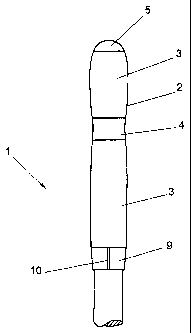Some of the information on this Web page has been provided by external sources. The Government of Canada is not responsible for the accuracy, reliability or currency of the information supplied by external sources. Users wishing to rely upon this information should consult directly with the source of the information. Content provided by external sources is not subject to official languages, privacy and accessibility requirements.
Any discrepancies in the text and image of the Claims and Abstract are due to differing posting times. Text of the Claims and Abstract are posted:
| (12) Patent: | (11) CA 2600075 |
|---|---|
| (54) English Title: | HANDLE FOR A CLEANING DEVICE |
| (54) French Title: | ELEMENT DE MANIPULATION POUR UN APPAREIL DE NETTOYAGE |
| Status: | Granted and Issued |
| (51) International Patent Classification (IPC): |
|
|---|---|
| (72) Inventors : |
|
| (73) Owners : |
|
| (71) Applicants : |
|
| (74) Agent: | BORDEN LADNER GERVAIS LLP |
| (74) Associate agent: | |
| (45) Issued: | 2011-04-19 |
| (86) PCT Filing Date: | 2006-02-22 |
| (87) Open to Public Inspection: | 2006-09-21 |
| Examination requested: | 2007-09-05 |
| Availability of licence: | N/A |
| Dedicated to the Public: | N/A |
| (25) Language of filing: | English |
| Patent Cooperation Treaty (PCT): | Yes |
|---|---|
| (86) PCT Filing Number: | PCT/EP2006/001595 |
| (87) International Publication Number: | WO 2006097181 |
| (85) National Entry: | 2007-09-05 |
| (30) Application Priority Data: | ||||||
|---|---|---|---|---|---|---|
|
The invention relates to a handle (1) for a cleaning device. Said handle
comprises at least one handle base (2) having at least one convex first handle
section (3) and, axially adjacent to the first handle section, at least one
concave second handle section (4). The invention is characterized in that the
first handle section has a higher coefficient of static friction than the
second handle section.
La présente invention concerne un élément de manipulation (1) pour un appareil de nettoyage. Cet élément comprend au moins un corps de manche (2) qui présente au moins une première section de manche convexe (3) et, placée de manière axialement adjacente à celle-ci, au moins une seconde section de manche concave (4). Selon cette invention la première section de manche présente un coefficient de frottement statique qui est supérieur à celui de la seconde section de manche.
Note: Claims are shown in the official language in which they were submitted.
Note: Descriptions are shown in the official language in which they were submitted.

2024-08-01:As part of the Next Generation Patents (NGP) transition, the Canadian Patents Database (CPD) now contains a more detailed Event History, which replicates the Event Log of our new back-office solution.
Please note that "Inactive:" events refers to events no longer in use in our new back-office solution.
For a clearer understanding of the status of the application/patent presented on this page, the site Disclaimer , as well as the definitions for Patent , Event History , Maintenance Fee and Payment History should be consulted.
| Description | Date |
|---|---|
| Common Representative Appointed | 2019-10-30 |
| Common Representative Appointed | 2019-10-30 |
| Grant by Issuance | 2011-04-19 |
| Inactive: Cover page published | 2011-04-18 |
| Inactive: Final fee received | 2011-02-04 |
| Pre-grant | 2011-02-04 |
| Notice of Allowance is Issued | 2010-08-11 |
| Letter Sent | 2010-08-11 |
| Notice of Allowance is Issued | 2010-08-11 |
| Inactive: Approved for allowance (AFA) | 2010-07-30 |
| Amendment Received - Voluntary Amendment | 2010-02-19 |
| Inactive: S.30(2) Rules - Examiner requisition | 2009-12-30 |
| Amendment Received - Voluntary Amendment | 2009-06-26 |
| Inactive: S.30(2) Rules - Examiner requisition | 2009-04-16 |
| Amendment Received - Voluntary Amendment | 2009-02-23 |
| Amendment Received - Voluntary Amendment | 2008-11-19 |
| Inactive: Cover page published | 2007-11-22 |
| Inactive: Acknowledgment of national entry - RFE | 2007-11-19 |
| Letter Sent | 2007-11-19 |
| Inactive: First IPC assigned | 2007-10-10 |
| Application Received - PCT | 2007-10-09 |
| National Entry Requirements Determined Compliant | 2007-09-05 |
| Request for Examination Requirements Determined Compliant | 2007-09-05 |
| All Requirements for Examination Determined Compliant | 2007-09-05 |
| Application Published (Open to Public Inspection) | 2006-09-21 |
There is no abandonment history.
The last payment was received on 2011-01-18
Note : If the full payment has not been received on or before the date indicated, a further fee may be required which may be one of the following
Please refer to the CIPO Patent Fees web page to see all current fee amounts.
Note: Records showing the ownership history in alphabetical order.
| Current Owners on Record |
|---|
| CARL FREUDENBERG KG |
| Past Owners on Record |
|---|
| ELISABETH ARNBERG |
| FALK LINDNER |
| KEIJO LINDHOLM |
| MALIN OREBAECK |
| MARCUS HENEEN |
| OLLE BOBJER |
| PETRA BARGON |
| PETTERI OJAMO |
| SVEN-ERIC JUHLIN |